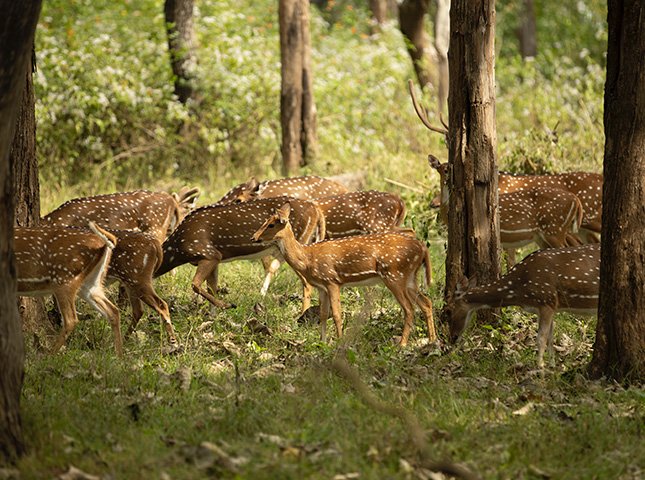Did you know that there’s a sneaky invader wreaking havoc in the United States? Meet the Axis deer, a non-native species that originated all the way from India and Sri Lanka. These crafty creatures were initially introduced for hunting purposes but have since become a major concern due to their invasive nature. The Axis deer’s adaptability allows them to thrive in various habitats across the country, outsmarting predators and causing quite a stir in local ecosystems.
With their rapid reproduction rate, these invaders are multiplying at an alarming pace, leading to significant population growth. This surge has caught the attention of news outlets nationwide as experts grapple with finding effective solutions to curb their impact. From urban areas to rural landscapes, Axis deer have infiltrated diverse environments, challenging authorities and leaving no stone unturned.
Prepare yourself for an eye-opening journey into the world of this notorious invasive species as we uncover its origins, behavior, and potential consequences for our delicate ecosystem. Brace yourself – things are about to get wild!
Table of Contents
Impact of Axis deer on local ecosystems and agriculture
The presence of axis deer can have significant impacts on both local ecosystems and agriculture. These deer species, originally from South Asia, have been introduced to various regions around the world, including North America. While they may be admired for their beauty, their presence can cause a range of issues.
- Compete with native wildlife for resources: Axis deer compete with native wildlife for essential resources such as food and water. This competition can lead to a decline in population numbers for native species.
- Damage crops and gardens through grazing: One of the most notable impacts of axis deer is their tendency to graze on crops and gardens. Their voracious appetite can result in significant damage to agricultural fields and backyard gardens alike.
- Alter vegetation composition in forests and grasslands: The feeding habits of axis deer can also alter the composition of vegetation in forests and grasslands. They prefer certain plant species over others, leading to changes in the overall diversity and structure of these ecosystems.
- Disrupt natural ecosystem balance: As axis deer populations increase, they can disrupt the natural balance within ecosystems. This disruption affects not only plant life but also other animal species that rely on specific plants for food or shelter.
The introduction of axis deer into non-native habitats has demonstrated how an imbalance in ecosystems can occur when a new species competes with existing flora and fauna. The impact on agriculture is particularly concerning as farmers face challenges protecting their crops from these browsing animals.
Efforts are being made to manage axis deer populations through methods such as hunting or fencing off agricultural areas. However, addressing the ecological consequences requires a comprehensive understanding of how these animals interact with their environment.
It is crucial for policymakers, land managers, and communities to work together to find sustainable solutions that mitigate the negative effects caused by axis deer while preserving biodiversity and supporting local agriculture.
Axis deer’s diet, habitat, and physical characteristics
Axis deer, also known as chital deer or hog deer, are herbivores that have a diverse diet consisting of various plants. They can be found in open woodlands and grassy areas near water sources. These beautiful creatures are easily recognizable by their reddish-brown coat adorned with white spots.
One remarkable feature of the axis deer is the impressive antlers possessed by the males. These antlers can grow up to 36 inches long and are shed annually. The fallow deer and native whitetail deer are other examples of species that possess antlers.
In terms of their physical appearance, axis deer resemble whitetail fawns when they are young but gradually develop into larger animals as they mature. Their size is comparable to that of elk, another majestic species within the deer family.
The axis deer population has been a subject of interest among hunters and wildlife enthusiasts alike due to their unique characteristics. As an animal species, they contribute to the biodiversity of ecosystems they inhabit.
To summarize:
- Axis deer are herbivores with a varied plant-based diet.
- They prefer open woodlands and grassy areas close to water sources.
- Their reddish-brown coat with white spots makes them easily identifiable.
- Male axis deer possess antlers that can reach up to 36 inches long.
- They share similarities in appearance with both whitetail fawns and elk.
With their distinctive features and adaptability, axis deer continue to captivate those who encounter them in the wild.
Presence of Axis deer in specific locations, such as Big Thicket in Texas
- Established populations found across multiple states including Texas, Hawaii, and Florida.
- Big Thicket National Preserve in Texas is home to a significant Axis deer population.
- Adapted well to the diverse habitats within the preserve.
The presence of Axis deer can be observed in various locations, with many axis deer populations established across different states. Notably, the Big Thicket National Preserve in southeast Texas stands out as one of these key areas where these beautiful creatures can be found.
Within the state of Texas itself, Axis deer have made their mark in numerous spots. The Big Thicket region specifically houses a substantial population of these majestic animals. This vast expanse of preserved land provides an ideal habitat for them due to its diverse landscapes and abundant resources.
Axis deer have proven their adaptability by thriving within the open areas and dense forests that make up the Big Thicket National Preserve. They are known for their distinctive white spots against a reddish-brown coat, which allows them to blend seamlessly into their surroundings. These white patches serve as a natural camouflage against the backdrop of trees and foliage.
Interestingly, Axis deer are not limited to just Texas; they have also been introduced to other regions such as Hawaii and Florida. In fact, some Hawaiian islands now boast thriving populations of these graceful creatures. Their ability to adapt extends beyond mainland environments, allowing them to thrive on these remote islands as well.
Researchers at institutions like Texas Tech University have studied the behavior and ecological impact of Axis deer within various ecosystems. Through their research efforts, valuable insights have been gained regarding how this species interacts with its environment and influences local biodiversity.
Efforts to manage and control the population of Axis deer
To effectively manage and control the population of Axis deer, various strategies have been implemented. These efforts involve hunting permits issued by state agencies, trapping programs to remove individuals from sensitive areas, collaboration between landowners, hunters, and conservation organizations, as well as promoting public awareness about the negative impacts of releasing captive animals.
- Hunting permits issued by state agencies: State agencies have established hunting permit systems to regulate the harvest of Axis deer. This helps in managing their populations by controlling the number of males harvested during hunting seasons.
- Trapping programs implemented to remove individuals from sensitive areas: Trapping programs are put in place to capture Axis deer that pose a threat or cause damage in sensitive areas such as agricultural lands or protected habitats. These captured individuals are then relocated or managed accordingly.
- Collaboration between landowners, hunters, and conservation organizations: Landowners work together with hunters and conservation organizations to coordinate efforts for effective wildlife management. This collaborative approach ensures a coordinated response towards controlling Axis deer populations.
- Promoting public awareness about the negative impacts of releasing captive animals: Educating the public about the detrimental effects of releasing captive Axis deer into the wild is crucial. By raising awareness about potential ecological disruptions caused by these introductions, people can make informed decisions regarding captive animal release.
By implementing these strategies and raising public awareness about responsible actions related to axis deer populations, wildlife management authorities aim to maintain a balance between conserving this species while minimizing any negative impacts they may have on natural ecosystems.
Conclusion
In conclusion, Axis deer, a species of deer native to India and Sri Lanka, have established populations in various parts of the United States. These deer have had significant impacts on local ecosystems and agriculture due to their browsing habits and ability to adapt to different habitats. They are known for their diverse diet, which includes grasses, leaves, fruits, and even bark. Axis deer prefer forested areas with access to water sources.
The presence of Axis deer has been observed in specific locations such as Big Thicket in Texas, where they have become a notable part of the local wildlife. However, their increasing population has led to concerns about overgrazing and damage to natural vegetation.
Efforts are being made to manage and control the population of Axis deer through hunting programs and other methods. These initiatives aim to strike a balance between preserving the biodiversity of local ecosystems while minimizing agricultural losses caused by these invasive deer.
To ensure effective management strategies for Axis deer, it is crucial for individuals and communities alike to be aware of their impact on the environment. By understanding their behavior and habitat preferences, we can contribute towards sustainable conservation efforts.
FAQs
Are Axis deer harmful to native wildlife?
Axis deer can negatively impact native wildlife by competing for resources such as food and habitat. Their presence can disrupt ecological balance in certain areas.
Can I hunt Axis deer?
Yes, hunting programs are often implemented as a means of managing the population of Axis deer. However, it is important to follow all applicable regulations and obtain proper licenses before engaging in hunting activities.
Are there any benefits associated with Axis deer?
While they may pose challenges for local ecosystems and agriculture, some argue that the presence of Axis deer adds diversity to wildlife populations in certain regions.
Do Axis deer pose risks to humans?
Axis deer generally avoid human contact but may become aggressive if they feel threatened or cornered. It is advisable to maintain a safe distance and avoid approaching them.
How can we support efforts to manage Axis deer populations?
Supporting local conservation organizations, participating in hunting programs, and spreading awareness about the impact of Axis deer are some ways individuals can contribute to population management efforts.


